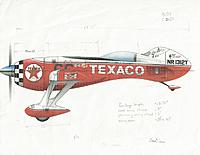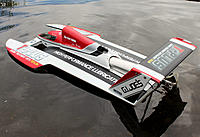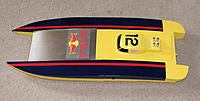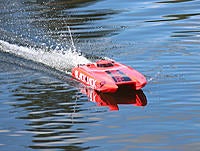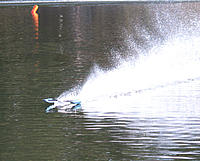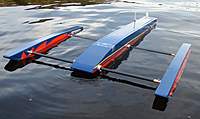Posted by cyberhoops |
Nov 30, 2020 @ 12:44 AM | 13,207 Views
I have always been a fan of the GeeBee and have built and flown a 48" span version of the R1. I am also a big fan of the fantasy GeeBee R3. With credit to Mirco Pecorari, the Italian designer and artist who created the original drawing of the GeeBee R3 - I decided to create a 3D printed version of the airplane. Back in the 80's I did make a park flyer version of the R3, but that plane is long gone. This version will be a static model, about 10" long, printed in PLA. I have most of the CAD work done and have printed a few test parts. As far as I know the only original art is a side view, so wing shape and a lot of the details are left to the imagination. I decided to go with something like the Spitfire elliptical wing and tail surfaces generally shaped like the original GeeBee.
If it all works out I will probably upload the STL files to Thingiverse.
I will update the blog once I get a bit farther along with printing, painting and assembly.
The Thingiverse location is:
https://www.thingiverse.com/thing:4670634/files
I have printed all of the parts and everything looks pretty good. I thought that the wing span looked a bit big when test fitting the pieces together - but - the original GeeBee R was 17'8" long with a wing span of 25'. That makes the ratio about 1.41. My R3 model is about 9.6" long and using the same ratio the desired span would be about 13.5". My current is 14", which is pretty close - maybe a tad long but not terrible. I have now adjusted my model to shorten the span down to 13.5".
And finally - the 95% complete build of the prototype. I actually added some guy wires using stretchable thread (EZ-Line), but not until after taking these pictures. It is mostly hand painted with cut vinyl decals and "print and cut" vinyl decals for the Texaco star.
Posted by cyberhoops |
Sep 29, 2020 @ 03:02 PM | 7,561 Views
I got inspired by water jet drives to design and 3D print a mono hull for a jet drive. Initially I used a small TFL drive, which led to 3D printing a two stage M-jet drive and the getting a metal 36mm drive unit.
The general intent is to use these boats for oval racing in the club, and maybe as my upgraded rescue boat. There might be enough interest to start a new class for club racing, or maybe race them against SV-27s.
All the hulls are basically the same, with revised transom geometry to fit the specific jet drive. The hulls are 27" long and 8 to 8.5 inches wide depending a bit on how wide the flat spot is for the intake. They have a dead rise of 22 degrees. The hull is printed in PLA with a thickness of 1.5mm, except the transom at 4mm thick and flat plate to mount the drive which is 3mm. The transom is printed with 70% infill and everything else is 15%. The full hulls with carbon fiber inlay weighs in at 24 ounces.
There are also little inserts on the outside edges at the joints between sections for alignment and strength.
They are all being powered by UL-1 motors, 120 amp ESCs on 4S.
The TFL boat has been tested one time. It worked nicely, but I should have sealed better around the drive at the transom. Water filled the boat and killed the servo limiting the testing. My first test was with a 1450kv motor, and it was a bit slower than an SV27. I think it will get up to that speed, roughly 35mph.
...Continue Reading
Posted by cyberhoops |
Mar 20, 2018 @ 07:22 PM | 8,413 Views
It has been a while since I built a boat from scratch, and this would be the first V hull from scratch - the 1/6th scale Crackerbox from Jerry Dunlap plans to make a 31" boat. I scaled up some 1/10th scale plans, ordered wood and away we go. The full size boats are a maximum of 15' 6" in length, which is 31 inches in 1/6th scale. The 1/10 plans were for a 20" boat, which is actually too big. I scaled up by 155% to get the right size. I also deviated from the plans when building the cockpit and front hatch, but otherwise it follows the plans.
The club added this as a new class this year, using P-Limited power, scale like fins, tabs, centered rudders and the prop under the transom... And turning left, like the real boats. We did allow flex drive, and do not require a straight shaft, with the hope of getting a slightly better handling boat. I am going to start with a ProBoat Dynamite 1500kv motor, which should be plenty of power. I think staying upright in a race is probably more important than whatever turns out to be the top speed.
As with most of my wood boats, it is constructed from 1/8" plywood bulkheads, with 1/32" decking. The deck support pieces are 1/16" plywood. The transom is doubled to be 1/4".
With this update I am almost up to paint, which means I am putting on the finishing coats of epoxy and sanding. The bare wood boat without drivers and running gear weighed in at 2lbs 11oz. The 3D printed vintage
...Continue Reading
Posted by cyberhoops |
Nov 05, 2015 @ 01:18 PM | 11,294 Views
After getting a 3D printer a few months ago, I have been making a few mini Unlimited hydroplanes.
The bigger models are 7" long, which fits inside my 8 inch build area. The smaller boats are 3.5" long. They are mostly hand painted with the text being waterslide decals - except for the white text which is hand painted since I can't make white waterslide decals.
I have modeled the 30' Karleson hull, a 30' "drop sponson" hull, and the 1983 Renault hull. I am working on the 1973-1975 Winged Wonder Pay'n Pak hull.
The Karleson hull was a variety of boats including the national champion checkerboard Bardahl from 1968, the 1971 Hallmark Homes and the 1969 Notre Dame.
The drop sponson boat is the 1971 Miss Madison, which was the underdog Gold Cup winner that year.
Then we have the 1983 Miss Renault, which is just one of my favorite boats.
Posted by cyberhoops |
Aug 04, 2015 @ 10:32 AM | 11,636 Views
I decided to get my "geek" on and purchase a 3D printer. My son-in-law got this all started and we both now have a FolgerTech Prusa i3 printer.
After some test prints my first project with the printer was to make a turbo Allison 1/10th scale motor for a friend who is building the 1976 Atlas.
Given that I do development work on a CAD system as the day job it was not a huge stretch to start working on a model of the Allison. I ended up breaking it down into 40 parts, to make printing easier. It takes about 12 hours to print all of the pieces, but the result turned out pretty good if you ask me.
Posted by cyberhoops |
Sep 22, 2014 @ 01:42 PM | 12,317 Views
Over the past couple months I have been rebuilding an older 1.10th scale hydroplane hull, repairing the damage and getting it repainted - and finally the work is complete. This is probably one of the nicely looking boats I have done to date.
The original hull was built by Mark Beatty, somewhere around six years ago, but when I started the boat had gotten hit in a race and was pretty badly damaged. The problems included: The tail fins needed to be rebuilt, the cowling was broken, there were several holes and cracks in the hull. There were quite a few very thin spots in the wood just from the age of the hull. After sanding off the old paint, I put a layer of fiberglass cloth over the entire boat and then filled and sanded everything back down to a smooth surface. I ended up making new tail surfaces and patching up the cowling.
The paint is Rustoleum 2x Painter's Touch and the vinyl decals are from Mike McKnight at Thunderboat Graphics.
The power system will be a ProBoat Dynamite 1800Kv motor on 4S, spinning one of the 46mm CNC 3 blade props from Offshore Electric.
Posted by cyberhoops |
Nov 09, 2013 @ 12:51 PM | 12,767 Views
And update: I changed the sponsons from being angled (dihedral) to a flat running surface - and a flat strip from way up at the nose to the transom. That made all of the difference. The boat runs great now - turns nicely without a tendency to hook - no plowing a bit of water off the nose at moderate speeds - no extra turn fins or anything special required. The lean turned out to be a rudder problem. It was not quite vertical, and just a bit of angle in the rudder was lifting one sponson.
- back to the build -
The wood chips and sawdust have been cleaned up in the shop, the sun came out, at least for a while, so here are some pictures of the completed catamaran build. It will be UL-1 powered or 4S Lipo, using the Swordfish 120 Pro+ ESC. I am really looking forward to getting some data back from the Swordfish.
The finished boat weighs 3lbs 7oz without batteries, so about 4.5lbs with batteries.
And here are some pictures of Kyle's version of the cat. This one was laser cut.
Just to update the story.
My first test with the T-Plus cat did not work out that well. Instead of running with a 42x55 prop I was actually using an H7. In "Octura" terms I thought I was testing with a 342 and instead I had a 548. Well, I burned up the motor inside 2 minutes and that took out the ESC. I got the data off the ESC and it was drawing 90 amps on average, which is a bit over the top for a 60amp motor.
So, the next test was with new UL-1 motor
...Continue Reading
Posted by cyberhoops |
Oct 18, 2013 @ 02:29 PM | 13,131 Views
My project to build a new catamaran for club racing is making good progress. The basic wood working is complete and I can start looking at position of the hardware and a finishing coat of epoxy on the wood. The basic wood hull weighs in a 1lb 9oz, so realtively light for a 28" boat.
Posted by cyberhoops |
Oct 13, 2013 @ 11:16 PM | 14,967 Views
Well, it is that time of year again ( post race season ) when the shop turns back into a boat building site.
First up on the list is a catamaran for racing in the club limited spec catamaran class and as an offshore class boat. I am going with the classic catamaran plans that JesseJ and Shockerman posted a few years back on the Offshore Electric forums. I built a version of this boat in 2009 for my son to race, but it is time to build one for me. The planned power system will be a UL-1 motor running on 4s lipos with probably a Hobbywing 120 amp ESC.
I am going to tweak the design a bit. The original plans scale to a 30" cat that is 8 1/2 inches wide. I am going to increase the width and make a 28.5" cat that is 10 1/2 inches wide. This is more comparable to the current cats like the Motley Crew, Mean Machine and so forth that are in the 10 to 11 inch wide range for a 30 inch cat.
The increased width will also make it easier to have an offset rudder, which is something I want to do with this version.
After 7 days of building I have the basic cat ready up to the top decking. I need to get the motor and motor mount setup to make sure I have clearance before laying down the top deck. It is a nice solid boat hull at this point.
...Continue Reading
Posted by cyberhoops |
Apr 07, 2013 @ 10:54 PM | 13,388 Views
We had our first club race ... here are some pictures. This is not all of the classes of boats we run, or all of my pictures from the day. It was nice and sunny, which was a change of pace for March. A good day.
...Continue Reading
Posted by cyberhoops |
Jan 07, 2013 @ 12:13 PM | 14,061 Views
Getting toward boat racing season again, and I have not done much this year to this point. That should all change in the near future since I plan to start building a 1992-3 Miss T-Plus, twin wing hull in 1/10th scale.
The Twin Wing design was the brainchild of Ron Jones Jr, along with Dave Villwock. Villwork won his first race in that boat using under the sponsorship of Coors Dry. Other variants of that boat include the Circus Circus, Exide and of course the T-Plus.
Craig Bradshaw at West Coast Custom Boats is building me a carbon fiber hull which is looking quite good, and I have contacted Mike McKnight at Thunderboat Graphics for the decals. I will need to do ride pads, hardware and paint. I will post more pictures as I get into the build process.
--- time passes ---
And the build did get completed. It took far more time than I would have expected but in the end it all worked out. The first run was for a race and while the boat was not exceptionally fast, it was stable. I can work on props and balance for a bit more speed.
--- Later update ---
The twin wing is fast! I raced it for a couple years and it ran nicely, then sold the boat to a club member. He tweaked the boat to use a straight shaft drive system, added a bit of nose weight, lowered the strut, switched to a new ABC prop and wow - the boat is easily over 50mph - say 55? and a good turning stable boat. Kicking some serious water.
Posted by cyberhoops |
Oct 16, 2012 @ 06:41 PM | 16,452 Views
I was playing around with a couple Nerf guns, and reading some of the posts about people modifying Nerf guns for better performance. One thing led to another and I could not resist the idea of making a chronograph, or velocity sensor, for Nerf darts.
I had all of the hardware I needed already lying around - mainly an Arduino controller, and an LCD display. Add to that a pair of infrared LED light sources and detectors from Radio Shack and I was good to go.
The idea was to place the two sensors in a PVC tube spaced 4 inches apart. Then time how long it takes for a dart to trip the two sensors and compute speed. Since the Arduino can do timing in microseconds it is more than capable of doing accurate speed for a dart moving around 100fps.
The Arduino 5v output is connected to the transmitter led through a 270 ohm resistor and to ground. Two analog input pins are connected to the receivers and then a 270 ohm resistor to ground. Very simple circuitry. The LED's are mounted 4 inches apart in a 1 3/8 inch PVC tube. About the only thing I did wrong was not mounting the LED's to be flush with the inside of the tube. My mounting has them sticking into the tube about 1/8", which means the dart can hit them. That means I have to be slightly more careful in settup up the shot to go down the middle of the tube.
Once the speed is calculated, the display is a Sparkfun LCD-09395 serial LCD with 2 lines of 16 characters. That just takes 5v power, ground and a single digital output pin from the Arduino which makes it very simple to use. After the picture was taken I also added a second line to the display for the average velocity of the previous 5 shots.
It did not take long to get it all working - 30 minutes to get the first breadboard version working and a couple days to put it all together.
It anyone is interested in the code (Arduino sketch), or the circut diagram, let me know and I can make that available.
Posted by cyberhoops |
Apr 05, 2012 @ 07:15 PM | 14,516 Views
The boat building season is (mostly) complete, and now we are into racing.
The new boats made it out for the first race day, and after some initial tweaking they ran very nicely.
The Hallmark flipped in heat 1, but gained a second in heat 2 and won heat 3. The Hallmark only needed a slight adjustment in the CG and fixing the rudder angle.
The Renault flipped in heat 1, had a loose drive dog issue for heat 2, and finished second in heat 3. I added an air dam to the bottom of the tunnel which should reduce the lift and keep the boat on the water.
The Red Bull finished all three heats and ended up with the overall win in the P-Mono class. This boat is still a work in progress for prop selection, but it is coming along.
All of the boats got some tweaks and should be ready to go for the next race. Construction is not quite done, since Kyle got a new LSH hull from ML Boatworks - their Sport 20 hull. So, that should be ready to race in a couple weeks.
Posted by cyberhoops |
Nov 15, 2011 @ 02:27 AM | 15,329 Views
While waiting for graphics to arrive for the Renault, and with the arrival of laser cut pieces for the U-32 Hallmark Homes I started construction of the second boat for the winter building season. The boat parts were laser cut by Mike at ML Boatworks, and they are very nice. Everything has slotted together perfectly.
The cowling was made by Mitch Dillard from the Classic Thunder club, and it is also a very nice piece.
The original boat was the former Miss Bardahl - the classic checkerboard Bardahl which won the national title back in 1968. In the 1971 Gold Cup in Madison Indiana the Hallmark Homes hit the rooster tail of the Atlas and sunk just 30 seconds into the race. Fortunately the driver, Lief Borgerson was not injured, but the boat was a total loss. I am hoping for a bit better luck with this boat than that.
The initial test run at the lake was promising for the Hallmark Homes. Running with a Proboat 1500 motor and an aluminum 645 prop the boat seems to get up and go just fine. I moved the batteries just a bit more forward after the test run, but overall it was a great initial test.
...Continue Reading
Posted by cyberhoops |
Oct 12, 2011 @ 12:59 AM | 15,647 Views
Well, the Puget Sound Fast Electric race season is over, and thus begins building season.
The race season was fairly successful and I ended up 2nd overall in Limited Sport Hydro racing the Insane FE30.
The first building project will be the 1983 Miss Renault. I need a new 1/10th scale boat that will be lighter and hopefully faster than my current Miss 7-Eleven. I also tried the Circus Circus, but it was never running right. Like the real boat it did complete one heat and finished last. That boat is again retired.
At this point there were at least 3 boats in the club far faster than my 7-11 and a couple new boats being built. I think part of the cause is that the 7-11 hull weighed a fraction over 5 lbs, and something like 7 1/2 when ready to race. Meanwhile the Oberto hull we built last year weighed 2lbs 3oz, and was highly competitive. I am hoping the Miss Renault hull will come in at about 2 1/2 lbs and maybe 5 lbs ready to race. Construction of that boat has already started and the basic hull framing and sheeting of the sponsons is complete.
After that I think I will also build a classic roundnose 1/10th scale boat and race that class next year as well. That boat is looking to be the 1971 U-32 Hallmark Homes and will be built from laser cut bulkheads.
...Continue Reading
Posted by cyberhoops |
May 09, 2011 @ 12:03 AM | 15,507 Views
Saturday was another race day for the Puget Sound Fast Electric Club, and Kyle and I had a good day of racing. The weather... not so good. It was cold, windy and raining the entire day.
I managed to win the LSH class and Offshore class while Kyle won the P-Hydro class and 1/10th scale Modern class. In Offshore I was certainly not the best boat or driver, but I managed to finish 3 heats while rough water and wind flipped the other boats at least once. In the end I guess things even out since the last race we flipped and broke boats.
The only damage this week was a fried motor in the Circus Circus which again failed to really get up on plane. Since it was dragging a bit in the water that increased the current draw and toasted a Stilleto motor. It is time to retire that boat once again and go back to the Miss 7-Eleven. I think it might be a pretty reasonable boat with more power, but the P-Spec power system is just not enough to get it up and running properly. I may test it again at some point with the Fiegao 580L motor we have since that is probably enough power to get it working.
I managed to get a couple pictures of the 1/10th scale O'Boy! Oberto up and running. Most of the pictures were blurred because there was not enough light for my camera to take a picture with a high enough shutter speed to avoid motion blur.
Posted by cyberhoops |
Apr 24, 2011 @ 10:52 PM | 15,680 Views
Saturday was a perfect spring day for the Pacific Northwest and the second race of the season. (Actually the club's third race, but I missed one for a trip to Cancun.)
On one hand it was a successful day with my American Dream (Insane Fe30) wining the LSH class. Beyond that I twisted and broke the drive shaft on the Circus Circus, and the motor on the SV seized up taking it out of the mix. Both boats went down without even running a heat.
Kyle's day was also mixed. Hit managed to flip boats or hit bouys in 9 of the 15 heats he entered, but did manage to get his JAE Rigger up to 57.8mph using a modified 1650 prop.
Still a nice day for racing and we had fun.
Posted by cyberhoops |
Mar 22, 2011 @ 12:13 PM | 16,511 Views
We had our first official race for Puget Sound Fast Electric at the park in Granite Falls.
There were 11 drivers in attendance and roughly 38 boats in 8 different classes. The weather cooperated nicely and although it was a bit chilly (34 degrees) at the start of the day it probably hit the 50's by the afternoon with mixed sunshine and overcast conditions.
The racing was fun. I ended up winning the SV27 and Offshore categories (mostly by finishing all of the heats), coming in 2nd in LSH, and a distant third in 1/10th scale modern.
Greg Schweers took the OPC Tunnel, LSH and P-Spec Hydro classes, Byron Pimms was the 1/10th scale modern and classic winner, Scott Bickford won the P-Mono title.
The video below is some of the testing and the OPC Tunnel heat 1 race.
Since the race I have been working on props for the American Dream LSH boat with at least a bit of success. The original 1445 prop had the boat going about 46.8mph, and then 47.5 and 48.9mph with two different cut down 1450's. I did a bit of cupping on the tips of the 1445 and now I am getting 50.0mph with that prop. That has to be the easiest boat I have ever setup and it looks so smooth at 50mph. I know that there are people who have gotten runs of 55mph with the UL-1 motor and an ABC H5 prop, but I think they were running a Turnigy 120 ESC and pushed the timing up to 15 degrees. I think 50 is pretty good for a UL-1 speed control, but I am going to continue to experiment.
Posted by cyberhoops |
Mar 14, 2011 @ 11:17 PM | 17,579 Views
Saturday was a test day for the club, and we brought nearly the full fleet of boats to test. It rained the entire day, but other than that the testing was good.
For the most part it was a successful test day - especially since we didn't break anything. The Beacon Plumbing (Zephyr 27) and American Dream (Insane FE30) ran very nicely and are basically dialed in and ready to race.
The rigger (JAE21 FE) worked flawlessly but needed more get up an go, so we have changed out the Proboat motor for a UL-1 motor. The additional 400 to 500 Kv should take that boat up into the 50mph range.
The Oberto had more trouble getting up on plane, so the sponsons have been modified again to get more angle of attack. We will see on Sunday for the first race if that will work. When it did get up on plane, then the boat is quite fast.
Posted by cyberhoops |
Mar 08, 2011 @ 08:55 PM | 16,984 Views
With 3 days to spare I finally completed the work on a Zipkit JAE21 FE rigger. This coming Saturday will be the first test day of the race season with the PSFE club. This should be a fun little boat to race.
Since the weather was nice today, and rain is expected for the weekend I took the boat over to the lake for some quick pictures.
The boat is currently Proboat powered, but that will likely change to UL-1 power at some point. All of the hardware is from Zipkits, along with a Traxxas waterproof servo, a cut down 1450 prop and a Turnigy 120 ESC.
The ESC is tucked away under the battery, and the battery has about a 1/16th inch clearance to the hatch.... tight, but it fits.
I am looking forward to Saturday - rain or shine.
 Views: 118
Views: 118  Views: 117
Views: 117  Views: 123
Views: 123  Views: 114
Views: 114  Views: 111
Views: 111  Views: 128
Views: 128  Views: 132
Views: 132  Views: 119
Views: 119  Views: 328
Views: 328  Views: 314
Views: 314  Views: 330
Views: 330  Views: 297
Views: 297  Views: 300
Views: 300  Views: 313
Views: 313  Views: 282
Views: 282  Views: 316
Views: 316 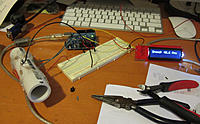 Views: 458
Views: 458  Views: 488
Views: 488  Views: 390
Views: 390  Views: 385
Views: 385  Views: 421
Views: 421 